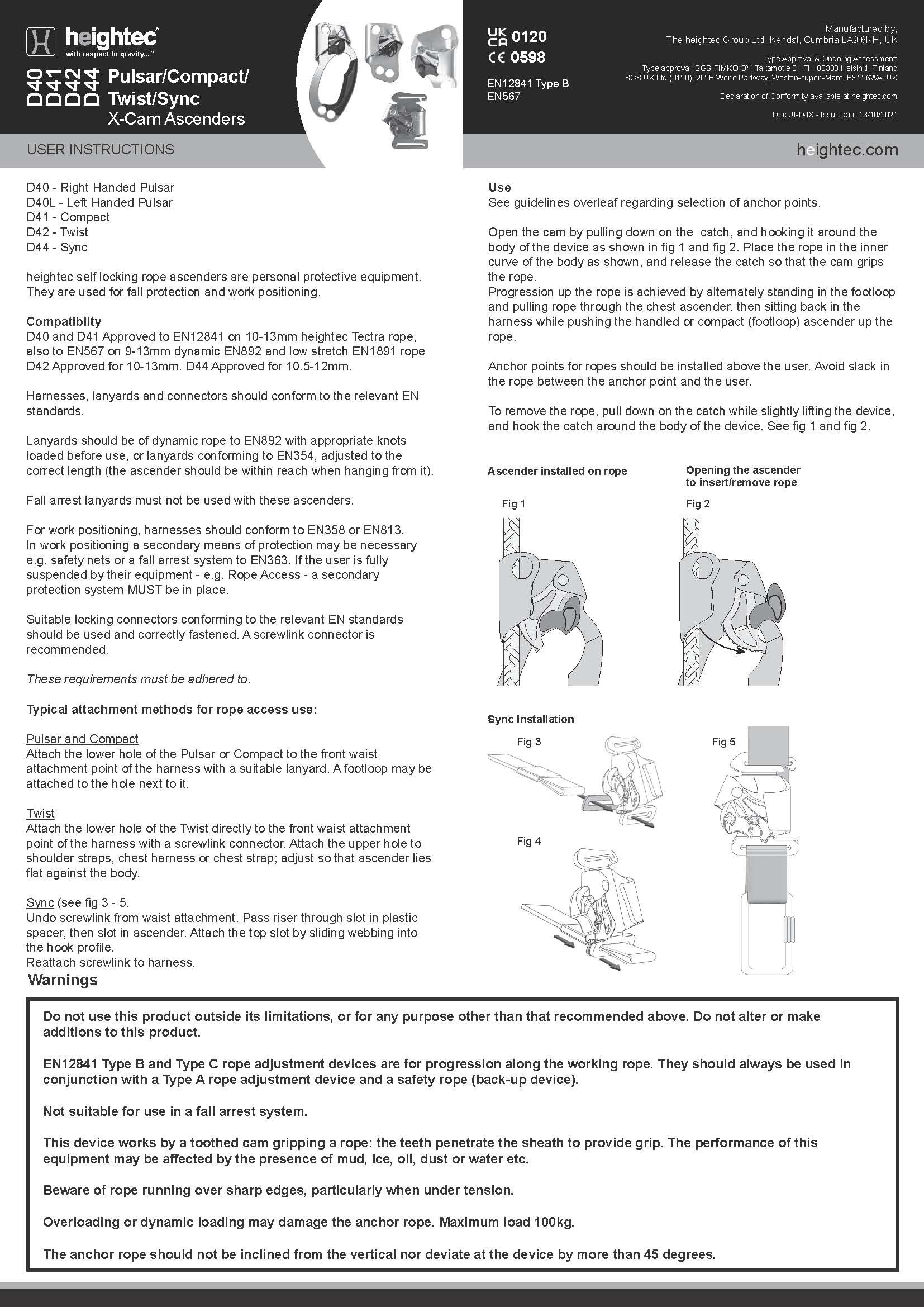Overview
Heightec once marked some of their products with the "heightec-PMI" brand for sale by PMI in the U.S.A.
[ Top
| heightec-PMI, v. A
| heightec-PMI, v. B
| Return to H.E.C. Ascenders
]
heightec Pulsar X-Cam
(D40L & D40)
(#3503/3504)
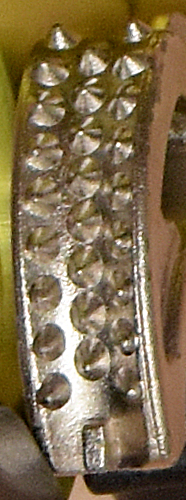 Technical Details
Technical Details
I acquired my heightec Pulsar X-Cam D40L/D40 from heightec in 2022.
The heightec Pulsar X-Cam D40L is 32 mm. tall, 92 mm. wide, 30 mm. thick, and weighs 232 g. The rope channel is 16 mm. wide. The cam axle is centered 48 mm. from the inside of the rope channel. The cam radius increases from 33 to 53 mm. over an angle of 45°, giving a 31° cam angle. The tooth pattern is (2)(1.2)^8(B).
The rear of the shell is printed with "D40" ("D40L" on the left-hand ascender), "Pulsar," "Ascender," the heightec logo, "heightec," book-with-an-"i" icon, a human icon, "↑," "UKCA," "CE0598," "EN567:2013," "EN12841:2006 type C," "•Ø9-13.0 mm," "100kg," and "291021." It is stamped "C0616" on the left-hand ascender, and "D2148" on the right.
|
 |
Warning:
The weight ("100kg") printed on the shell can easily be
less than the weight of a fully loaded caver. |
 |
|
The cam has a different tooth pattern than the earlier heightec-PMI versions. The new cam is taller, has a steeper cam angle, and has 26 rather evenly spaced teeth vs. 20 less evenly spaced teeth on the older version. I don't notice any difference in how well the two versions work on normal-size 9 to 11 mm. caving ropes, but the changes facilitate using the larger battleship mooring hawsers that the bigger-is-better crowd seem to prefer.
[ Top
| heightec
| heightec-PMI, v. B
| Return to H.E.C. Ascenders
]
heightec-PMI Pulsar, Version A
(D40)
(#256, 2093)
Technical Details
I acquired my heightec-PMI Pulsar D40, Version A from On Rope 1 at
the 2008 Old Timers’ Reunion. I acquired another in 2017 as part of Bob Thrun’s collection.
Version A is 193 mm. tall, 91 mm. wide, 26 mm.
thick, and weighs 228 g.
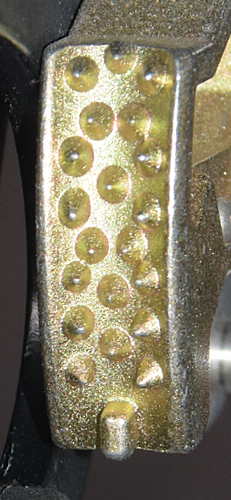 The shell is a tall irregular shaped stamping made from 4.2 mm. aluminum alloy sheet metal. A 15.4 mm.rope channel is
formed in the upper portion of the left side and a smaller cam
channel lies opposite on the right. A hole drilled through both
sides of the cam channel accepts a 6 mm. rivet. The cam and
cam spring are mounted on this rivet. The head of the rivet is
on the front of the shell. The pivot is centered 51 mm. from
the inside of the rope groove. There is a 4.9 mm. high, 7.9 mm.
cam stop pin riveted to the shell. The handle below the cam has
a soft "rubbery" hand grip molded into place. The hand
grip has a cusp to support the index finger. A 15.0 mm. sling
attachment hole is punched below the handle opening, and a 15.1 mm.
hole is punched below and outside the first. A 15.0 by 17.9 mm.
oval hole through both sides of the rope channel provide an attachment
point just above the cam.
The shell is a tall irregular shaped stamping made from 4.2 mm. aluminum alloy sheet metal. A 15.4 mm.rope channel is
formed in the upper portion of the left side and a smaller cam
channel lies opposite on the right. A hole drilled through both
sides of the cam channel accepts a 6 mm. rivet. The cam and
cam spring are mounted on this rivet. The head of the rivet is
on the front of the shell. The pivot is centered 51 mm. from
the inside of the rope groove. There is a 4.9 mm. high, 7.9 mm.
cam stop pin riveted to the shell. The handle below the cam has
a soft "rubbery" hand grip molded into place. The hand
grip has a cusp to support the index finger. A 15.0 mm. sling
attachment hole is punched below the handle opening, and a 15.1 mm.
hole is punched below and outside the first. A 15.0 by 17.9 mm.
oval hole through both sides of the rope channel provide an attachment
point just above the cam.
The cam is a plated skeletonized steel casting. The cam radius,
measured from the pivot, increases from 38 to 52 mm. over
an angle of 38°, giving a 25° cam angle. The cam has number
of small conical teeth, all of which have their axes approximately
perpendicular to the cam face. The tooth pattern is (1.2^3)^2(1.2)^2(B).
The B stands for a small bar. A spring-loaded manual safety is
mounted on an axle riveted to the bottom center of the
cam. The normal action of the spring holds the safety against
the cam. The safety has a 12.8 mm. tall, 6 mm. diameter
pin mounted on it for the fingers. When the cam is opened, the
shell interferes with the safety, thus preventing cam opening.
At full open the safety can be released and the spring will hold
the tab against the back of the shell, locking the cam open.
The front of the rubberized had grip has "heightec"
molded into it. The rear of the ascender is printed with "D40A,"
a book-with-an-"i" icon, "Ø8-13," "0508 027,"
"heightec-PMI," and "www.heightec.com."
Unlike most handled
ascenders, Version A only came in a right-handed form.
This is such an obvious blunder that I have to give their staff a  Lemon Award.
Lemon Award.
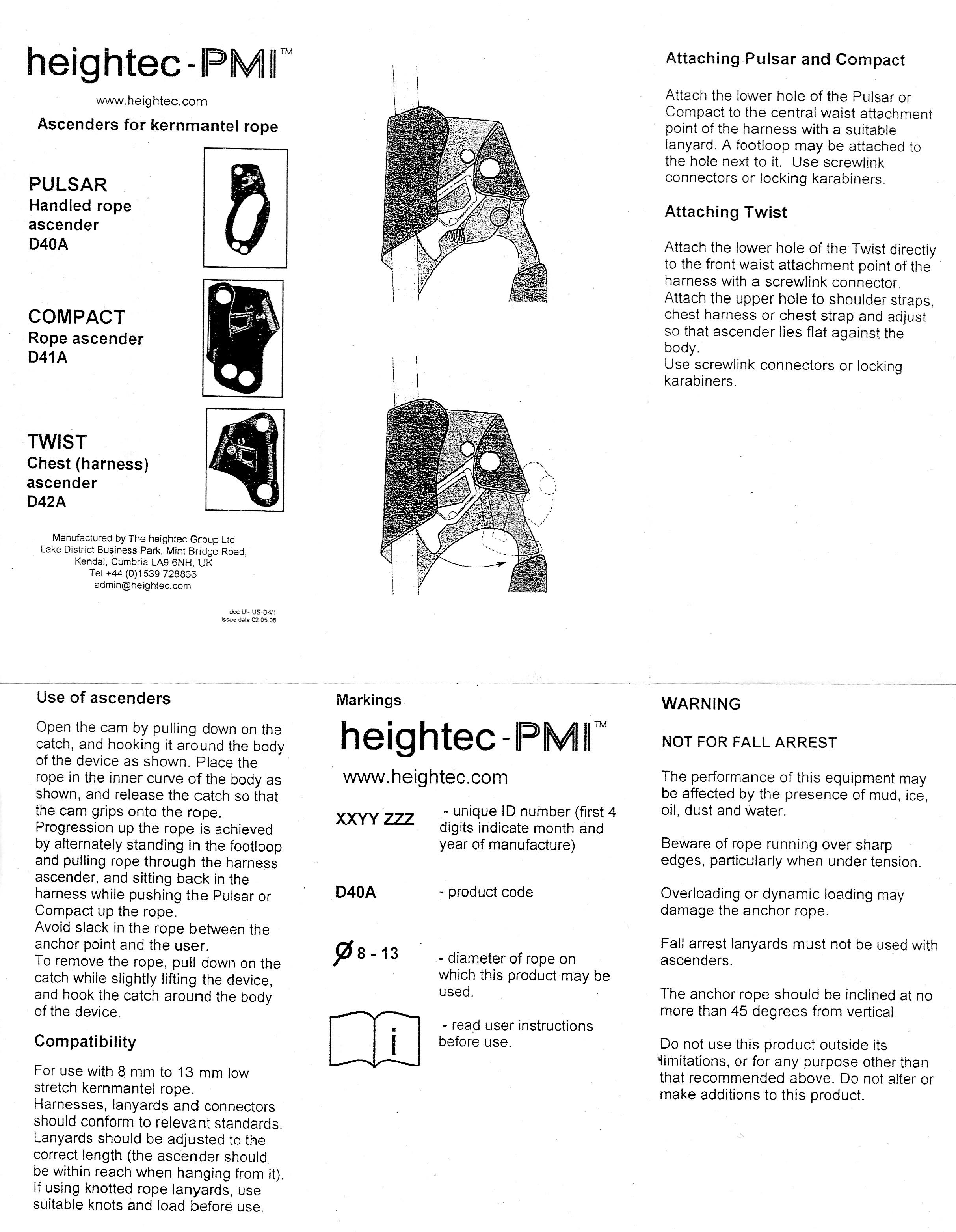 The D40 is a well-made ascender that performs much like the
Petzl Ascension. All sharp edges have
been removed. The attachment points are simply holes in the shell,
and although rounded they should have been beveled more; even
so, I would consider their small radius too sharp for directly
attaching sling ropes. They are probably acceptably rounded for
webbing (or could be made so), but considering the proximity of
the attachment points to the main rope, I would recommend using
a small maillon for most attachments in order to reduce the risk
of sling abrasion.
The D40 is a well-made ascender that performs much like the
Petzl Ascension. All sharp edges have
been removed. The attachment points are simply holes in the shell,
and although rounded they should have been beveled more; even
so, I would consider their small radius too sharp for directly
attaching sling ropes. They are probably acceptably rounded for
webbing (or could be made so), but considering the proximity of
the attachment points to the main rope, I would recommend using
a small maillon for most attachments in order to reduce the risk
of sling abrasion.
The handle is reasonably comfortable for me, but the cusp is
set too low for my large hands. A file can fix this. The safety
is moderately difficult to operate with one hand.
The lower attachment hole could theoretically have the same
safety problems as the one on Clog Version A.
The upper rope attachment hole is located very close to the main
rope. A carabiner through the upper attachment hole will probably
drag on the main line. Note that such a carabiner will prevent
putting the ascender on or off rope, so one’s climbing system
must be designed accordingly.
This ascender has the same pit lip disadvantage as the Clog and other stamped frame ascenders.
The shell is thicker that the one on the Camp
Pilot, Kong-Bonaiti, and Petzl
Ascension but it isn't reinforced as it is on those.
I'm not sure the extra holes are needed at the base. Except
for the Petzl Pompe, I've never
found a real need for a second hole. Some people like them, though. At least these are large enough for a carabiner to clip into. Frog climbers might prefer clipping their cows tail in here.
[ Top
| heightec
| heightec-PMI, v. A
| Return to H.E.C. Ascenders
]
heightec-PMI Pulsar, Version B
(D40LA & D40A)
(#1500, 2094, 2212)
Technical Details
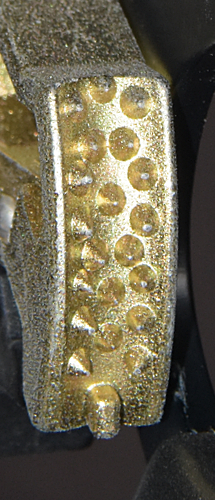 I acquired my heightec-PMI, Version B from On Rope 1 in 2009. I acquired another right-hand ascender and another pair in 2017 as part of Bob Thrun’s collection.
I acquired my heightec-PMI, Version B from On Rope 1 in 2009. I acquired another right-hand ascender and another pair in 2017 as part of Bob Thrun’s collection.
Version B is 191 mm. tall, 91 mm. wide, 29 mm. thick, and weighs 221 g. The right-hand Version B is identical to Version A except that Version B has a plastic cam safety. The left-hand Version B exists, unlike Version A because heightec-PMI forgot to invent a left-hand Version A, and so that one doesn't exist.
The rear of the shell is printed with "D40A" ("D40LA" on the left-hand ascender), a book-with-an-"i" icon, "• Ø 8-13" (only "8-13" on the left-hand ascender), "0209 184" ("1108 039" on the left-hand ascender), "heightec-PMI," and "www.heightec.com." One side of the handle (front on the left, rear on the right) has "heightec" in raised letters
Well, it seems that someone woke up and realized that people have left hands.
The cam safety is quite easy to operate with the matching hand, but awkward with the opposing hand. Most of the remaining comments for Version A apply to Version B as well.
[ Top
| heightec
| heightec-PMI, v. A
| heightec-PMI, v. B
]



